How much do you know about cars?
It’s not just trivia, either. Knowing some things about cars – or at least, some car lingo – can help you come across as more car-savvy, even if you’re not a gearhead. And that can help you avoid getting ripped off by a bad apple car salesman or service advisor. The bad ones are looking for marks – and if you appear to know something about cars, probably, they’ll save the shuck and jive for the next guy.
Anyhow, back to the lingo:
*OBD II –
This acronym refers to the Onboard Diagnostics II computer (and interface) that all cars have had for about 20 years now (since the mid-late 1990s). The OBD system governs the operation of the engine and related systems. If a problem is detected, a trouble code is stored in memory – accessible via a scanning tool that plugs in to a universal port (it’s the same in all cars, regardless of make/model) that’s usually located near the hood release catch in the driver’s side footwell area.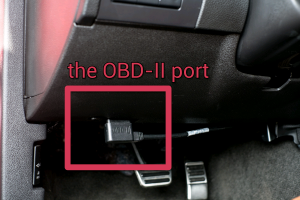
If a trouble code is thrown, the yellow “check engine” light in the main gauge cluster will come on and stay on, indicating the need for service.
Normally, this light only illuminates momentarily when you first start the engine, then goes off. If it comes on and stays on, it is not an emergency – you can continue to drive – but you should take the car in sooner rather than later to avoid a small issue becoming a big one.
Be aware: In states that have mandatory emissions testing, an illuminated “check engine” light will result in the car failing the test. Which usually means you can’t renew the vehicle’s registration – or get it, if you just bought the car used.
If you’re looking at a used car prospect, note whether the “check engine” light comes on at start-up and then goes off right away. If it stays on, there could be an expensive problem with the emissions controls, including the catalytic converter. You want that resolved before money changes hands.
Be sure to drive the car around for at least 15 minutes or so, incidentally. Because it’s possible someone with a scan tool (see below) cleared the trouble code(s) from memory. This will temporarily cause the “check engine” light to go out. But if the underlying problem that triggered the code wasn’t fixed, the light will come on again.
And if it does after money changes hands, it’ll be your problem.
If the “check engine” light comes on, a fairly common reason for that is a bad O2 – or oxygen – sensor. Take a look at your car’s exhaust system. You’ll see pipes and mufflers and things that kind of look like mufflers (these are the catalytic converters, which are mounted upstream from the mufflers). Somewhere forward (closer to the engine) you will also see a stubby little protrusion screwed into the piping, with an electrical pigtail on the back end of it. This is an 02 sensor – and your car may have several of them. Usually, there is at least one ahead of the catalytic converter – and one right after the catalytic converter. If your car has a V6 or V8 engine, you may have as many as four 02 sensors.
The 02 sensors sample the exhaust stream as it flows past, noting its chemical composition. This, in turn tells the OBD II computer whether the engine is running within spec and not too rich (excess gas in the air-fuel mix) and so on, which is critical for both emissions control and top performance/efficiency. If an O2 sensors goes bad, the computer is no longer receiving the data it needs – or receiving bad data – and a trouble code will get thrown and the “check engine” light will come on.
The upside is that with OBD – and a scan tool – it is possible for a technician to know whether the car has a bad 02 sensor rather than guess. The trouble code he pulls from the OBD II diagnostic port will tell him yes – or no.
You can do this yourself, too. Easily and fairly inexpensively. A hand-held OBD II scan tool costs about $120 (the better ones give you the code as well as tell you what the code means) and anyone who can turn an ignition key has the necessary skills to plug it into the OBD II port and pull the codes.
Even if you don’t want to do the actual repair work yourself, having the scan tool – and knowing what codes have been thrown can be very helpful when discussing your problem with a shop. You’ll know, for example, that they’re bullshitting you if they claim the OBD computer is telling them you’ve got “x” issue when you checked yourself and found the problem is actually “y”.
* Transaxle (vs. transmission and axle) –
This refers to the transmission/axle assembly in a front-wheel-drive (or front-wheel-drive-based) car. The two components are bolted together, rather than (as in a rear-drive, or rear-drive-based car) mounted separately.
Usually, the transaxle is removed (and rebuilt/replaced) as a single unit if major service is required. In contrast, if the car is rear-drive, the transmission is one thing – and the axle another. They are located in different parts of the car (axle in back, transmission up front, with a long driveshaft connecting the two).
If your car is a rear-drive car, the service guy shouldn’t be talking to you about problems with the transaxle.*
And if your car is front-wheel-drive, there should be no talk of “rear axle” issues.
(*There are some rear-drive cars with transaxles; the old VW Beetle, for example. Also some high-performance sports cars.)
* Timing chain vs. timing belt –
Both do the same job – time the motion of the valvetrain (camshaft, intake and exhaust valves) in syncopation with the rotation of the crankshaft (which in turn is turned by the up and down motion of the pistons, which are bolted to it via connecting rods). This timing must be very accurate for the engine to run properly. Or at all.
The valves need to open – and close – at just the right moment to either seal the combustion chamber (there are eight combustion chambers in a V8, six if it’s a six-cylinder engine – and so on) or allow air/fuel to enter – and spent exhaust gasses to escape.
The timing chain – or belt – keeps this dance happening by connecting the spinning crankshaft (being spun by the force of the explosions in the combustion chambers that drive the pistons up and down) to the also spinning camshaft (which rotates at a different rate). The camshaft (or camshafts, if it’s a double overhead cam engine) causes the valves to open and close.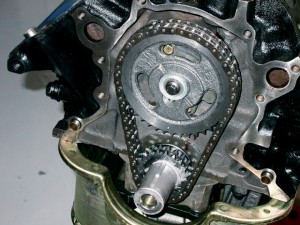
If the timing is off, the valves will open too soon – or too late.
In some engines – appropriately nicknamed crashers (more formally known as interference designs) if the timing is really off, there is the possibility of catastrophic mechanical failure resulting from a valve opening (pushing into a combustion chamber) at the same moment the piston is traveling upward.
If they kiss – bad news.
Luckily, there are very few crasher engines out there – and you probably do not own one. But regardless, it’s important to check your owner’s manual and service recommendations to see whether your car needs periodic timing belt replacements.
Timing belts are more common in Japanese/import-brand cars, while timing chains are more common in American brand cars – especially American cars and trucks with overhead valve (rather than overhead cam) V8 engines. The chains are usually good “for life” and while they may stretch a little at some point way down the road, many miles from new, they rarely fail. Timing belts, on the other hand, will eventually fail if not replaced per the recommended intervals (it’s typically every 75,000-120,000 miles). It won’t hurt the engine if that happens. Usually – assuming it’s not a crasher engine. But it will leave you dead in the water wherever you happen to be – and at the mercy of whatever repair shop happens to be nearby.
Better to get the belt replaced when the book says to get it replaced – when it’s convenient for you and you’ve had a chance to shop around for the best deal on the work.
The easiest way to grasp these often talked-about (but rarely well-explained) terms is to talk about which set of wheels break traction first.
If the back end of the car (rear wheels) begins to slide toward the outside of the curve, the car is oversteering. If uncontrolled, the back end of the car will swing around and you’ll be looking back the way you came.
If the front wheels lose traction (and slide) first, the nose of the car will try to keep on going in whatever direction inertia was carrying it – usually (in a corner) toward the outside of the curve. You probably won’t experience a 180 (or a 360). You’ll usually just run off the road onto the shoulder.
Front-wheel-drive cars tend to understeer because they are nose heavy – while rear-drive cars tend to oversteer because they are light in the tail.
If the car is an understeering car, backing off the throttle will help transfer some of the weight (of the car and momentum) rearward, which should help it recover traction.
Conversely, keeping on the throttle will help an oversteering-inclined rear-drive car hold its line by weighting the rear wheels, which enhances traction. But it’s not instinctive to keep your foot down in a fast curve. It’s something that you have to learn to do.
This by the way is why most production cars tend to understeer; in a panic situation (skid/slide) the average driver’s instinct is to back off the gas. Understeering – also called plowing – is generally safer for the novice driver to deal with than oversteer.
FWD cars with transaxles tend to be nose heavy because the weight of the engine, transmission/axle (transaxle) is mostly up front while in a rear drive car, the components are spread out more evenly along the length of the car – engine up front, transmission mounted behind it (rather than bolted to it sideways) and a separate axle back where the rear wheels are.
The FWD car is usually better in snow because of that weight on the drive wheels, which enhances traction – and because the drive wheels pull rather than push the car. A RWD car is usually not good in snow because the drive wheels (the rear wheels) don’t have much weight on them and so tend to break traction sooner and more easily on slippery surfaces.
If you value independent media, please support independent media. We depend on you to keep the wheels turning! And the Clovers carpet-chewing!
Our donate button is here.
If you prefer to avoid PayPal, our mailing address is:
EPautos
721 Hummingbird Lane SE
Copper Hill, VA 24079
PS: EPautos stickers are free to those who sign up for a $5 or more monthly recurring donation to support EPautos, or for a one-time donation of $10 or more. (Please be sure to tell us you want a sticker – and also, provide an address, so we know where to mail the thing!)


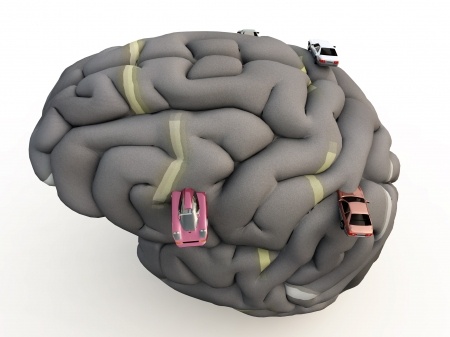

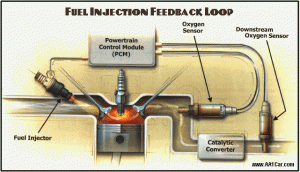







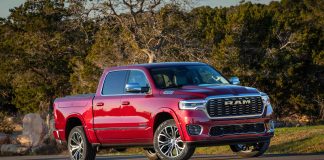
Good article, I would like to add to the check engine light portion regarding buying a used car, “If you’re looking at a used car prospect, note whether the “check engine” light comes on at start-up and then goes off right away. If it stays on…” If it doesn’t come on at all, someone has likely disabled the bulb, this is a common used car sales tactic, the light should always come on, key on, engine off briefly as a bulb check. I have stumbled across removed bulbs and cut wires to cover up check engine lights. Of course, this is where the OBD II scanner really earns it’s keep, if you have codes, but no light, you know you’re being scammed.
My Nissan truck had timing chain tensioner fail while driving down the road, bent all 4 exhaust valves, $350 in parts and 4hrs of my labor and she was back on the road. OBD scanners are not 100% accurate , had a Dodge Intrepid that was throwing error codes, 1 of which was a coil pack @ $80+ for replacement, turned out to be intake plennum gasket $7 and 2hrs work, found using spray bottle of water around gasket. And had a Honda Accord with MAP sensor ($400+) code that turned out to be a cracked vacuum line. On subject of under/over steer , was told by a Master Mechanic /Teacher at MAADA in Atl that all new cars must understeer by fed law.
Most common cause of a check engine light is a loose or improperly tightened gas cap. Something on the order of 70%. If it comes on soon after a fill-up that’s probably your problem.
Definitions:
Understeer – When you hit the wall with the front of your car.
Oversteer – When you hit the wall with the back of the car.
Horsepower – How fast you hit the wall.
Torque – How far you move the wall when you hit it.
Hi Mark,
Yup!
Many new cars (including the Hellcat I have right now) have capless fuel fillers – for just this reason. It avoids the problem of people not tightening the cap correctly and the OBD system detecting a problem with the evap emissions system.
I like the racer’s definition: Pushing [understeer] is when the front of the car hits the wall, loose [oversteer] is when the back of the car hits the wall.
“Front-wheel-drive cars tend to understeer because they are nose heavy – while rear-drive cars tend to oversteer because they are light in the tail.”
Um, excuse me, but isn’t “nose heavy” more or less equivalent to “light in the tail”? Since FWD is almost always way more front-biased in F/R weight distribution than RWD, one would expect FWD to be more oversteering than RWD, other factors being equal (which they obviously aren’t). In fact, my A1 Scirocco (BTW, anyone else here still driving one of those?) has a very pronounced lift-throttle oversteer – which comes in handy a lot of times, but can bite if you aren’t paying attention, especially in the wet – and, for any given speed through a curve, feels a lot more stable with the throttle down than the throttle up. It is certainly true that most production cars tend to understeer, but it’s not because most production cars these days are FWD.
Good description of over- vs. understeer. But I have the same question as ‘trying2b’ re the diff between nose heavy and light in the tail. Sounds like something from the Department of Redundancy Department.
Hi Phillip,
Part of it has to do with weight transfer. That is, by pushing down on the throttle in a RWD car, you “weight” the rear wheels, increasing traction. But in a FWD car, hitting the gas just puts more weight transfer on the front wheels, which (if they’re already sliding) will cause them to continue doing so.
OK, that helps me to understand it. The wording still seems questionable, w/o the additional explanation.
Let me try. Detroit used to make almost every car understeer. Now it didn’t have to be since many cars had a pretty good front to rear weight ratio but for their own reasons, they wanted people who pushed too hard to scrub out the front end and run off a curve head on. Some cars though were built with better weight ratios and suspension and steering geometry to be neutral and some were made, like the Porsche 911 with rear end weight and a natural tendency to oversteer when pushed too hard. I spent my early years studying this and practicing with everything I could get my hands on. One thing back then when suspensions and tires weren’t so great was to have enough power to turn a car that would normally understeer into something you could power on and turn into oversteer.
i was 18 before I had a car I could actually oversteer. It was all about horsepower, having more than necessary and being able to throw the rear-end out. It was also the reason you could, with enough power, go straight with the car sideways and continue to do this till you either overpowered it and spun it backward or let off the power and bring the nose around to the front. With enough power and enough skill you could keep that car going sideways for a long while though. Backing off brought the rear in line and more power brought the rear around.
It worked differently if you had an open diff or a limited slip. I’m sure we’ve all spun around on a road with full power and burned down one tire but be able to stay into it and pull it out and go straight. But, if you have limited slip and you don’t back out of it, that bad boy will continue to turn that circle even with opposite lock in the steering and all your fingers crossed.
Turn me loose with any car that can be overpowered and I could demonstrate it in a heartbeat. But oversteer is more often found in nicely balanced cars, front to rear weight wise.
Eric,
FYI, the last graphic for the over/understeer is backwards.
I was going to say that as well. They are easy for people to get reversed because of how they are typically explained. Eric explains it better than most by using traction.
Oversteer and understeer are rarely explained well in a way one can remember. I decided to remember understeer as the car not wanting to turn, going more straight than turning and oversteer as turning too much, the rear end coming around. When I did that the terms made sense. Too little steering and too much steering. under and over.
I think of understeer as something built into most cars, esp. cars of old from the Big 3, although not all of them. I think of oversteer as something that can be induced to some extent. But it all boils down to losing traction on the front or the rear in the inherent design.
I don’t know why but the memory of Big Red comes to mind. I wonder where it is.
Ach!
Fixed… thanks!
In relation to the interference engines: Don’t be too sure they’re not around as much.
I know for certain Dodge’s 5.7L Hemi is an interference engine. This is the ‘entry level’ V8 for their line and yeah, chain parts, dead block.
I had this happen to me on a relatively young (65k miles) engine a few years back and it’s still the same motor design they’re using today. The failure was a bad tensioner in a certain engine build run for Challenger’s, which caused the chain to break, but it meant I needed to get a whole new engine put in.
Hi Gabe,
Absolutely.
I always encourage people to read their paperwork – owner’s manual and service schedule – to know beforehand what they may be in for… and how to take steps to avoid such expensive problems.
Gabe, I think it was BrentP who posited the SBC’s were non-interference. From building those engines I’d say yes and no. It depended on the combination of piston, rocker arm and camshaft. Big lift cams and pistons with valve cutouts are always prone to interference when you lose a timing gear. Putting a one-off engine together was best done by using some machinist putty(ok, any putty)on top of the pistons, torquing a head down and turning the engine once. When you pull the head off the putty tells the story….sometimes it tells the story of a bright spot and no putty where the valve and piston touched. That’s when you try a thicker gasket and see if you can keep those parts from touching. When you’ve decked the block and the heads, you might have to get a set of new heads to solve the problem on fairly radical cams. The factory won’t make any such claim as to non-interference on any engine…..and they know on some of their hotter set-ups that getting the timing out of order will certainly result in a ruined engine. I had it happen on a Tonawanda engine. It was strange as they come with different types of lifters on the torque side from the drivers side. Camshaft number matched nothing in the GM catalogue and the pistons were of a different design than anyone had ever seen. Several SBC guru’s were convinced the engine had been worked on, changed up. It may have but it hadn’t been touched since driving off the showroom floor with zero miles on the odometer, plastic covers on the seats and throwaway floor mats. GM used to try some different things and this must have been a good effort cause that was a runnin sumbitch. At a bit less than 200K the damned nylon timing gear let go but it had virtually no wear on the cylinders. The rods were of a different sort too. I still have the rods and pistons although a friend talked me out of the block which he then let sit in the weather and ruin. I was pissed since the crank had obvious hand ground machining on it.
GM was like the proverbial box of chocolates back then. Sometimes what you got was much tastier than what you believed you were getting to paraphrase Forrest.
Eight, wasn’t me. I don’t know GM that good. I know some about Oldsmobile. I mostly play in Ford and Mazda land.
Brent, sorry to mention your name. As an engineer you know brand doesn’t matter, clearance does. I was always sorta amazed that the Probe was a better car than the Mazda. Saw a Probe recently looked showroom new, nice. Of course being on the interstate a lot I see a lot of everything. Saw a ’71 El Camino being trailered looked like showroom new too and an ’82 Elco with no hood on a trailer headed for the rebuild shop….same day. I love those old cars that look like new stock.
I’m pretty hip to GM stuff generally – and if anyone wants to talk old Pontiacs… I’m your guy!
All those VW Audi Group TDI engines are most definitely interference engines. And until last year, all of them had timing belts, not chains. The factory service interval for timing belts is at 115K or so. Given my history with timing belts and just being left on the side of the road, I’m thinking mine is going to be swapped at 100K.
And then I’m not ever going to buy another TDI unless it has a chain. I know chains aren’t perfect, but having a part that is guaranteed to fail spectacularly under the hood for no reason other than a little less noise is absurd.
Eric_G,
I don’t think VW went to a chain on the TDI (4 cyl. anyway), just saw a pic of the latest and greatest and looked like a belt to me. They did go to a chain on the TSI a few years ago and all you have to is Google VW timing chain to see how that worked out. I would stay away from any VW with a chain. They been trying it since 1993 and still haven’t figured it out. The VR6 and 2.5 5 cyl. mount the chain on the transmission end of the engine, imagine the labor on that. The ’93 thru mid ’97 VR6 wasn’t as bad, as they had a double row upper chain, but the root of the problem is not the chains but the nylon, plastic, whatever it is, chain guides and the crappy sprockets that seem to made of butter.
All this may have to do lack of maintenance, as some suggest, but i’ve seen low mileage, well maintained cars start rattling.
Hey Adam,
My mechanic buddy has this friend who is a little sick in the head… he has a modded-out VW (I think he has aftermarket jugs that upped the displacement to a 2400 or thereabouts) with a turbo and he says it’ll make 220 or so hp…
I asked my bud how this dude plans to keep it from melting… !
Just 220? I guess so, in a conservative steet car, in a full on 1/4 mile car, more like 500 or more!
Eric,
you should go out to a VW event sometime. There’s an event called Bug Out in your area at VMP, unfortunately it’s on Memorial Day weekend so you missed it. I’m sure there’s many more events on the east coast for VW drag racing.
Sounds like a case of no free dinners to me. I’ve built engines to rev to the moon so to speak and have never had a good double row timing chain and gears go away and that was on engines with no guides and a hell of a lot more torque and hp than those small VW engines.
What keeps a cam in a VW from walking around in the block? I’ve used cam buttons to keep one from going forward and backward which will eat up timing chain set on a high revving engine and eventually on a low revving engine BUT, that shouldn’t be a problem for a long time with good components and a lot of revving and slowing. Of course an all gear setup would last indefinitely.
Eightsouthman,
On an air cooled, thust bearings, on a water cooled (OHC) there is no cam bearings in the head, the cam spins directly in the head with trust controlled by the way the cam is machined with shoulders and the head has, like the main bearing caps in a SB Chevy, caps, that hold the cam in place, one of the caps used to control thrust.
Adam, right after I sent that I kicked myself realizing you were speaking of OHC. But thanks anyway. I got a good dose of OHC in a Nissan pickup I had.
When I rebuilt it if there’d been any way to get enough cooler in the front it would have had a SBC in it toot sweet. I’m sure I’d have had to put a different rear-end in it too but I had one as well as another TH 350.
The reason being, I got better fuel mileage or close to the same as that four with 3 times the power and something that would last forever in Tx. heat, something the Nissan couldn’t handle. I spent as much on machining and parts as a complete crate SBC would have cost. It was a learning experience for sure.
Good information. I really liked the over/under steering explanation. (Good use of pictures)
Thanks, Mith!